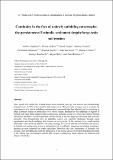Files in this item
Continuity in the face of a slowly unfolding catastrophe : the persistence of Icelandic settlement despite large-scale soil erosion
Item metadata
| dc.contributor.author | Dugmore, Andrew | |
| dc.contributor.author | Jackson, Rowan | |
| dc.contributor.author | Cooper, David | |
| dc.contributor.author | Newton, Anthony | |
| dc.contributor.author | Júlísson, Árni Daníel | |
| dc.contributor.author | Streeter, Richard Thomas | |
| dc.contributor.author | Hreinsson, Viðar | |
| dc.contributor.author | Crabtree, Stefani | |
| dc.contributor.author | Hambrecht, George | |
| dc.contributor.author | Hicks, Megan | |
| dc.contributor.author | McGovern, Tom | |
| dc.contributor.editor | Riede, Felix | |
| dc.contributor.editor | Sheets, Payson | |
| dc.date.accessioned | 2022-08-31T23:39:14Z | |
| dc.date.available | 2022-08-31T23:39:14Z | |
| dc.date.issued | 2020-09-01 | |
| dc.identifier | 262626588 | |
| dc.identifier | 2b677b00-4bab-4f21-ab09-29337d581728 | |
| dc.identifier | 85096557961 | |
| dc.identifier.citation | Dugmore , A , Jackson , R , Cooper , D , Newton , A , Júlísson , Á D , Streeter , R T , Hreinsson , V , Crabtree , S , Hambrecht , G , Hicks , M & McGovern , T 2020 , Continuity in the face of a slowly unfolding catastrophe : the persistence of Icelandic settlement despite large-scale soil erosion . in F Riede & P Sheets (eds) , Going forward by looking back : Archaeological perspectives on socio-ecological crisis, response, and collapse . Catastrophes in context , vol. 3 , Berghahn , Oxford , pp. 162-199 . | en |
| dc.identifier.isbn | 9781789208641 | |
| dc.identifier.isbn | 9781789208658 | |
| dc.identifier.other | ORCID: /0000-0003-2261-4540/work/80620642 | |
| dc.identifier.uri | https://hdl.handle.net/10023/25922 | |
| dc.description | The National Science Foundation of America provided financial support for this research through grants 1202692 ‘Comparative Island Ecodynamics in the North Atlantic’, and 1249313 ‘Tephra layers and early warning signals for critical transitions’. | en |
| dc.description.abstract | Soil erosion in Iceland since people first settled the island about 1,100 years ago has fundamentally changed some 15-30% of the island’s total surface area. This provides a unique case to evaluate the consequences of a slowly unfolding environmental catastrophe that has affected, and is continuing to affect a primary means of subsistence for a whole society. Buffered by the sufferings of regions of Iceland, individual farms and particular social groups, Icelandic society as a whole has endured through subsistence flexibility, social inequalities, and the ability to tap into larger provisioning and economic networks. This demonstrates how an adaptable people can confront challenges through social organisation and by diversifying their impacts ecosystems. In the medium term—multi-century timescales—this can be an effective, if costly, strategy, in terms of both the environment and society. Soil conservation is now a national priority, woodland is returning, and climate warming is opening up more potentials for Icelandic arable agriculture. However, the slow catastrophe of Icelandic soil erosion is still unfolding, with the perspective of the longue durée it is evident that decisions made in the Viking Age and medieval period still resonate, constraining future options for resilience and adaptive flexibility. | |
| dc.format.extent | 1921317 | |
| dc.language.iso | eng | |
| dc.publisher | Berghahn | |
| dc.relation.ispartof | Going forward by looking back | en |
| dc.relation.ispartofseries | Catastrophes in context | en |
| dc.subject | CC Archaeology | en |
| dc.subject | GN Anthropology | en |
| dc.subject | GE Environmental Sciences | en |
| dc.subject | SDG 13 - Climate Action | en |
| dc.subject.lcc | CC | en |
| dc.subject.lcc | GN | en |
| dc.subject.lcc | GE | en |
| dc.title | Continuity in the face of a slowly unfolding catastrophe : the persistence of Icelandic settlement despite large-scale soil erosion | en |
| dc.type | Book item | en |
| dc.contributor.institution | University of St Andrews. School of Geography & Sustainable Development | en |
| dc.contributor.institution | University of St Andrews. Bell-Edwards Geographic Data Institute | en |
| dc.date.embargoedUntil | 2022-09-01 | |
| dc.identifier.url | https://www.berghahnbooks.com/title/RiedeGoing | en |
This item appears in the following Collection(s)
Items in the St Andrews Research Repository are protected by copyright, with all rights reserved, unless otherwise indicated.

